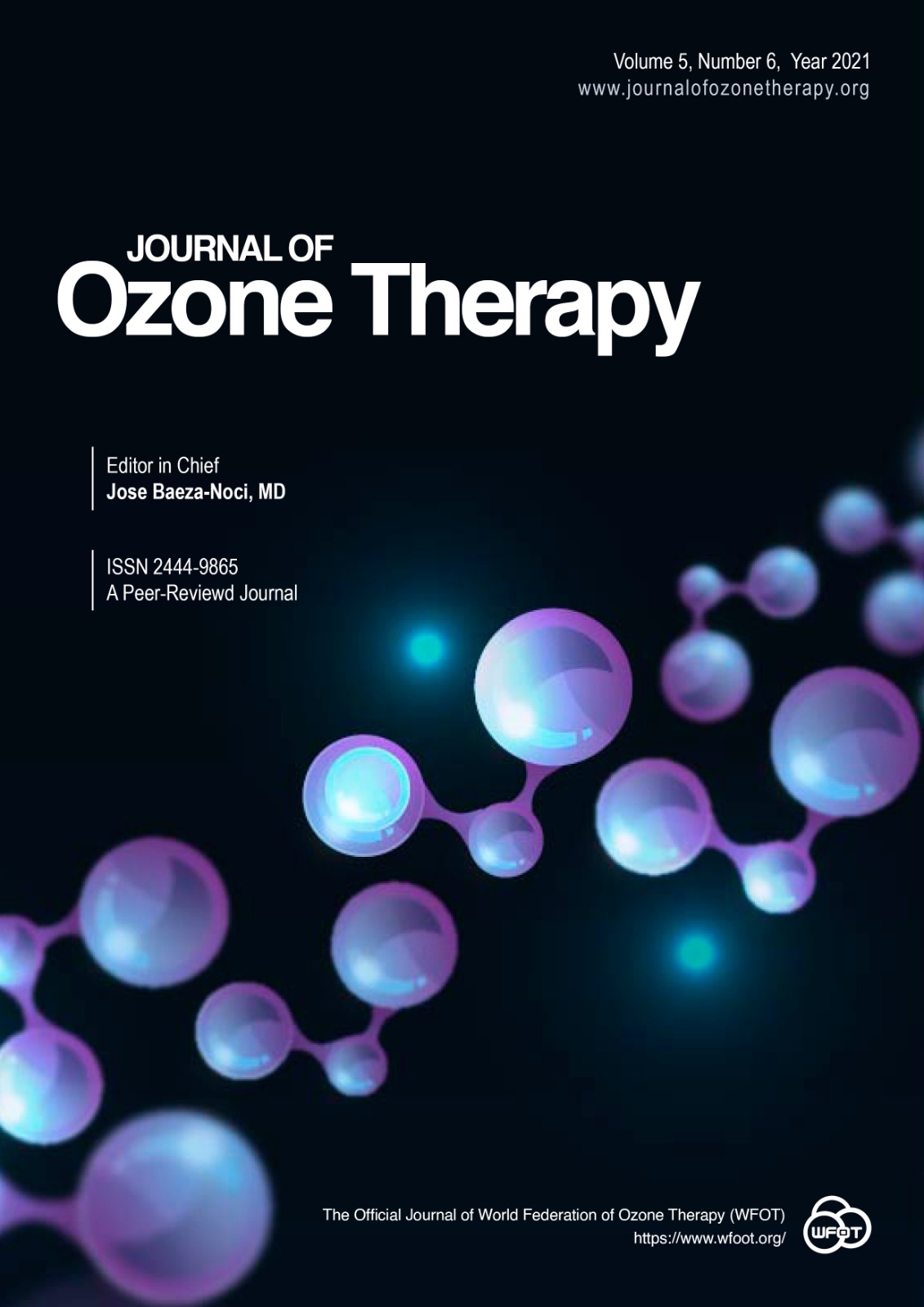Peritoneal oxygen / ozone insufflation (IPO3). Total remission of asthenia and pain in one terminal oncological patient after IPO3 cycle.
DOI:
https://doi.org/10.7203/jo3t.5.6.2021.14170Keywords:
intraperitoneal ozone therapy, tumor asthenia, palliative treatment, complementary treatment, quality of life, pain, cancer Abstract
Abstract
Pain and asthenia are symptoms of difficult control in cancer patients and greatly determine their quality of life. Conventional ozone therapy is used successfully in the symptomatic control of patients with cancer. We believe that the administration of ozone at high doses through IPO3 could provide an additional benefit in the control of refractory symptoms in patients with cancer.
We present below a cancer patient with very deteriorated quality of life, successfully treated with IPO3.
The patient is a 48-year-old woman with a history of breast cancer who has a disseminated metastatic recurrence that affects bones, skull, liver, lung and peritoneum, with symptomatology refractory to symptomatic medication. Her quality of life was limited by severe asthenia (which kept her bedridden for more than two months) and pain refractory to symptomatic treatment with opiates and corticosteroids.
The patient was treated with a cycle of rectal ozone therapy, consisting of a conditioning cycle with 15 sessions of oxygen / ozone rectally, followed by placement of a peritoneal catheter to subsequently perform five IPO3 sessions.
At the end of the treatment, all the symptoms of the patient were resolved completely, allowing the withdrawal of all the analgesic medication, returning the patient to a normal life. There were no side effects, and the beneficial effects of this IPO3 cycle were maintained for more than two months. The analysis showed diminution of the tumor and inflammatory markers during the treatment.
Ozone therapy at high doses should be considered in cancer patients with severe symptoms and refractory to conventional treatment.
 Downloads
Downloads
 References
References
Tirelli U, Cirrito C, Pavanello M, Del-Pup L, Lleshi A, Berretta M. Oxygen-ozone therapy as support and palliative therapy in 50 cancer patients with fatigue – A short report. Eur Rev Med Pharmacol Sci. 2018;22(22):8030-8033. doi:10.26355/eurrev_201811_16432.
Bocci V, Zanardi I, Perez-Olmedo JC, Travagli V. A technically feasible treatment for peritoneal carcinomatosis. Int J Ozone Ther. 2012;11(2):85-89.
Gandey A. Studies show quality of life linked to cancer survival [internet]. New York (NY): Medscape; 2008 Jun 19 [cited 2019 mar 6]. Available from: https://www.medscape.com/viewarticle/576355.
Borrelli E, Bocci V. The use of ozone in medicine. Ann Med Health Sci Res. 2018;8:117-119.
Schulz S, Haussler U, Mandic R, Heverhagen JT, Neubauer A, Dunne AA, Werner JA, Weige E, Bette M. Treatment with ozone/oxygen-pneumoperitoneum results in complete remission of rabbit squamous cell carcinomas. Int J Cancer. 2008;122:2360-2267.
Peirone C, Mestre VF, Medeiros-Fonseca B, Colaço B, Pires MJ, Martins T, Gil da Costa RM, Neuparth MJ, Medeiros R, Bastos MMSM, Marques-Magallanes JA, Oliveira PA. Ozone therapy prevents the onset of dysplasia in HPV16-transgenic mice - a pre-clinical efficacy and safety analysis. Biomed Pharmacother. 2018;104:275–279.
Königsberg FM, Nrf2: La historia de un nuevo factor de transcripción que responde a estrés oxidativo, Rev Educ Bioquimica. 2007;26(1):18-25.
Sagai M, Bocci V. Mechanisms of Action Involved in Ozone Therapy: Is healing induced via a mild oxidative stress?. Med Gas Res. 2011;1:29. doi:10.1186/2045-9912-1-29.
Luongo M, Brigida AL, Mascolo L, Gaudino G. Possible therapeutic effects of ozone mixture on hypoxia in tumor development. Anticancer Res. 2017;37(2):425-436. doi:10.21873/anticanres.11334
Boticario Boticario C, Cascales Angosto M. Hipoxia y cáncer. An. R. Acad. Nac. Farm. 2010;76(3):379-408.
Wu MZ, Cheng WC, Chen SF, Nieh S, O'Connor C, Liu CL, Tsai WW, Wu CJ, Martin L, Lin YS, Wu KJ, Lu LF, Izpisua-Belmonte JC. miR-25/93 mediates hypoxia-induced immunosuppression by repressing cGAS. Nat Cell Biol. 2017 Oct;19(10):1286-1296. doi:10.1038/ncb3615.
Sweet F, Kao MS, Lee SC, Hagar WL, Sweet WE. Ozone selectively inhibits growth of human cancer cells. Science. 1980 Aug 22;209(4459):931-933.
Honn KV, Cicone B, Skoff A, Prostacyclin: a potent antimetastatic agent. Science. 1981 Jun 12;212(4500):1270-1272.
Rossmann A, Mandic R, Heinis J, Hoffken H, Kussner O, Kisncherf R, Weihe E, Bette M. Intraperitoneal oxidative stress in rabbit with papillomavirus-associated head and neck cancer induces tumoricidal inmune response that is adoptivelly transferable. Clin Cancer Res. 2014;20(16):4289-4301. doi:10.1158/1078-0432.CCR-14-0677.
Bette M, Nowak-Rossmann A, Mandic R. The auricular VX2 carcinoma is a suitable animal model for identifying biomarkers for HNSCC therapy response. Anticancer Res. 2018 Sep;38(9):5067-5078. doi:10.21873/anticanres.12826.
Springmann VC. Auswirkung von O3/O2-gasgemisch im peritoneum auf zytokinproduktion und schmerzinduktion. [Effect of O3 / O2 gas mixture in the peritoneum on cytokine production and pain induction] [master’s thesis]. [Marburg (Germany)]: Universität Phillips Marburg; 2014.
Zorraquin G, Zorraquin G. Simpaticectomias distonicas etiopatogenicas, viscerales, al ozono y octozono intraperitoneal, en lugar de simpaticectomias operatorias. [Dysthopathic etiopathogenic sympathectomies, visceral, to ozone and intraperitoneal octozone, instead of operative sympathectomies]. Semana Medica. 1947;54(3):61-66.
Van-Es RJ, Baselmans AH, Koten JW, Van-Dijk JE, Koole R, Den-Otter W. Perilesional IL-2 treatment of a VX2 head-and-neck cancer model can induce a systemic anti-tumour activity. Anticancer Res 2000;20:4163–70.
Downloads
Published
How to Cite
-
Abstract1195
-
PDF542
Issue
Section
License
Journal of Ozone Therapy applies the Creative Commons Attribution-NonCommercial 4.0 International License (CC BY NC 4.0) license to works we publish.
Under this license, authors retain ownership of the copyright for their content, but allow anyone to download, reuse, reprint, modify, distribute and/or copy the content as long as the original authors and source are cited. No permission is required from the authors or the publishers.
You may not use the material for commercial purposes.
Appropriate attribution can be provided by simply citing the original article, provide a link to the license, and indicate if changes were made.
You may do so in any reasonable manner, but not in any way that suggests the licensor endorses you or your use.




